I've never met a carbohydrate I didn't like! I am in love with Turkish bread: pide. So what exactly is pide? Well, it's a Turkish bread that can be eaten plain or stuffed. Some of the most popular stuffing choices are: seasoned lamb, feta, or spinach.
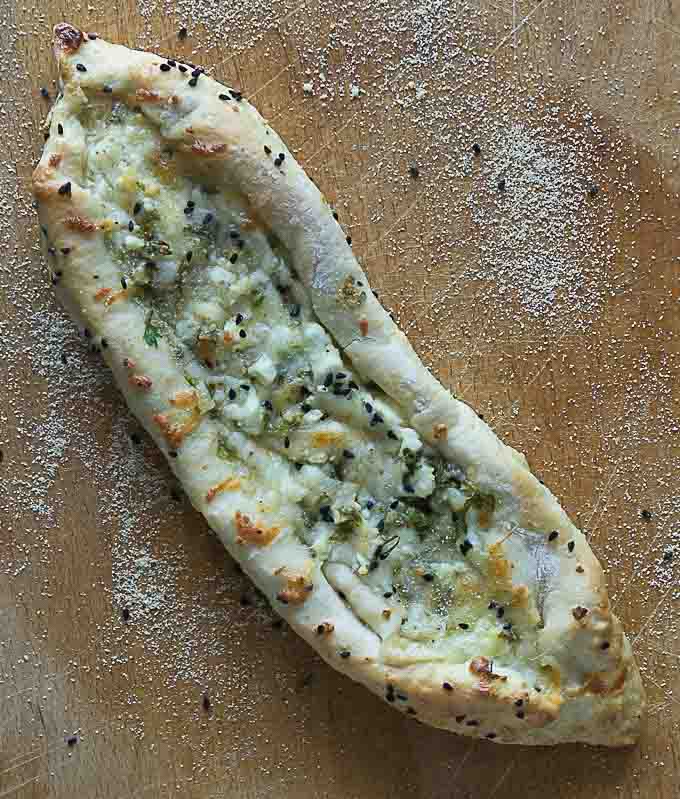
You don't have to be a baker
Don't let the fact that this is bread scare you away from making it. It is so easy, and I am not the bread baker in the family. If you can mix, knead, and roll, you can do this. My first attempt was successful, and the pide looked prettier the first time than it did the second time. I think I overfilled them or something. Don't worry the ones I am showing you here are really pretty. You all know that I like pretty food.
Think about it like a Turkish pizza. You've probably made homemade pizza before. It definitely poses its own challenges, but at its core it's a simplistic dish. Same goes here. You can customize it endlessly with a variety of toppings, or you can keep it simple.
What is Pide?
Pide is a boat-shaped Turkish bread. İçli pidemeans "stuffed" or "garnished pide". That's what we'll be making today. The middle is filled with herbs, cheeses, vegetables, and meats too. In Turkish restaurants, you'll typically find pide ekmeği ("pide bread"), which is a flat bread similar to pita. There is another kind that is only served during Ramadan, the month-long period of reflection, fasting, and prayer. It's the sweet version topped with sesame seeds.
The one we'll be making today dates back to around the year 1850. According to The Guardian, bakers in a small town called Bafra would stuff their breads before baking them. Since then, people have been stuffing it with virtually anything they want or have on hand.
This dish is perfect for when you have company over. It's not only impressive since this dough is homemade, but it's also versatile so you can adjust to different diets. Use only veggies and cheese to make it vegetarian. Have vegan friends? Use vegan cheese and veggies.
Turkish pide background
There are also regional differences. Similar dishes to pide can be found throughout Central Asia, the Middle East and Eastern Europe. It would be similar to pizza when comparing Turkish cuisine to dishes from other regions. In Turkey there are street shops that specialize only in pide, they are called "pideci." It is street food at its best, but it's also something you can make at home and accompany with a side salad, and voila, a great weekday meal has materialized. As for the side salad, you'd probably want to keep it on the lighter side with a vinaigrette dressing. I have a great arugula salad recipe you can check out that would go great with this carby goodness.
It has so many culinary influences. You can think of it as the cousin to Middle Eastern flatbreads or Italian pizza. Its diversity is owed to many factors, including geography, rich flora and fauna, and of course the sultan's kitchen from the days of the Ottoman Empire. The fact that Turkey was influential in the spice trade is another bonus to its rich cultural heritage.
Common fillings
Like a pizza, Turkish pide can be made with a variety of toppings. Some favorites include ground meat with onions, Turkish cheddar cheese, feta cheese, spinach, and pastrami, or even with Turkish spicy sausage and cheese.
Some folks even crack an egg on top toward the end of its baking. It's important to emphasize near the end of baking or as soon as it comes out of the oven because if you crack it too early, you risk overcooking it and ending up with a hard egg. You want the egg to be slightly runny still, but with the whites mostly cooked.
To be more specific, it's common to see meats like lamb, or chicken which are very popular on pide. For veggies, expect some sliced bell peppers, red onion, and sliced tomatoes. Add fresh herbs like mint, parsley, or even cilantro to give the bread some much-needed brightness and freshness. To me, herbs are always the cherry on top to a great meal.
For the cheese, it's common to use cheddar, feta, ricotta, and even a low-moisture mozzarella (it melts easier than fresh mozzarella!).
Overall, I was pleasantly surprised to find out I could make traditional Turkish pide straight from my American kitchen. So many of the ingredients they use in Turkey exist here in the U.S.
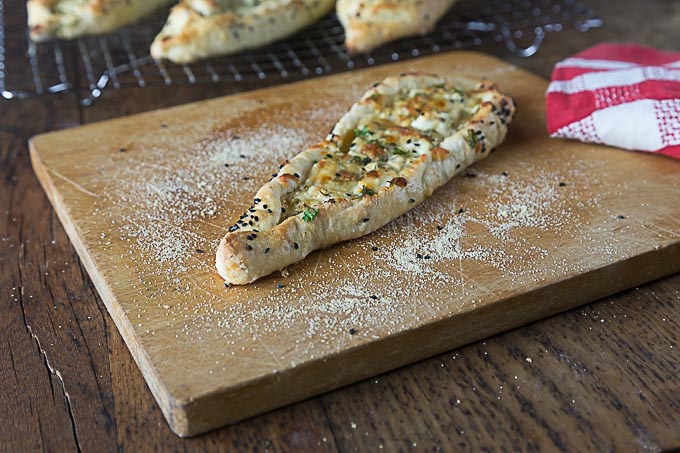
Step by step photos

- Gather all your ingredients and have them chopped, measured and ready to go before beginning.
- In a large bowl place the flour and the salt. Stir to combine.
- Warm up ¾ cup of water in the microwave to a temperature between 100°F-110°F.
- Add the yeast and sugar to the warm water and stir. Let this sit until frothy which is usually 5-10 minutes.
- Pour the yeast mixture into the flour and mix well with your hands. You can do this with a stand mixer and dough hook if you prefer.
- Continue mixing until the dough forms a ball.
- Lightly coat the sides of a bowl with olive oil and place the dough. Cover and let it sit at room temperature until it has doubled in size. Preheat your oven to 400°F while it proves.
- Beat one egg with 1 tablespoon water and the remaining olive oil to make an egg wash. Set this in the refrigerator for later.
- Once the dough has doubled in size punch it down then knead it on a floured surface for 5 minutes.
- Form a ball and cut into 4 equal pieces.
- Mix together the feta, mozzarella, chopped parsley, cinnamon and black pepper.
- Roll out each piece of dough to approximately a 12 inch x 3 inch oval. Place the cheese mixture down the center of the dough.
- Pinch together the ends of the oval and fold the sides inward.
- Dust a baking sheet with cornmeal and place the pide on top. Brush the egg-wash all over the sides and ends with the egg wash.
- Sprinkle the egg washed areas with some nigella seeds.
- Bake for 12-15 minutes until golden brown and crispy.
Frequently asked questions
- How long can I store the pide in the refrigerator? Once they have completely cooled you can store the in the refrigerator for up to 3 days. Place them in an airtight container or zip top bags.
- How can I reheat the pide? Reheat in the oven at 250°F for 10 minutes until warm in the center. I like to put them in my Cosori Air Fryer
for 5 minutes at 250°F.
- Can I freeze the pide? Yes, you can freeze these for up to two months in an airtight container after they are completely cooled. Reheat in the oven at 250°F for 10-12 minutes or 10 minutes in an air fryer at 250°F.
- How long does it take for the dough to double in size? The rise time is largely depends on the room temperature where you prove the dough. Typical times are 45 minutes for a 70° F room. Proofing drawers are usually 80°-90°F with 75% humidity and can cut the time in half.
Although traditionally, kaser peynirli (a type of Turkish cheese) is used, I am sort of a fan of feta, so I use it combined with mozzarella; I know mozzarella isn't exactly Turkish, but it works. My preference is to add parsley instead of spinach. I love spinach, but there is something about cooked spinach that I can't get past. Now give me a spinach salad, and I am all over it. As an added touch, before baking, I like to sprinkle my pide with nigella seeds; I think they add a nice peppery flavor, plus a great visual contrast too. You can get nigella seeds on Amazon if your store does not carry them.
Do you want to try some other savory baking? German zwiebelkuchen is a tasty sweet onion quiche with bacon that is easy to make. Potato, bacon and Gruyere tart is another family favorite with its melted cheese and hint of herbs. Pogacas are another delicious Turkish pastry but the main flavor is feta cheese. Spicy Chicken Puff Pastries are a delicious Latin American snack that go well with a cup of strong coffee.
Looking for more recipes?
Sign up for my free recipe newsletter to get new recipes in your inbox each week! You can also find me sharing more inspiration in Pinterest and Facebook
📖 Recipe

Turkish Bread: Pide Recipe Card
Ingredients
Dough:
- 2 ¼ cups flour
- 1 cup water warm
- 2 ¼ teaspoon dry active yeast
- 1 teaspoon sugar
- 1 teaspoon salt
- ½ tablespoon olive oil for oiling the bowl to prove the dough and egg wash
Filling:
- ¾ cup Feta crumbled
- ⅔ cup mozzarella shredded
- ¼ curly parsley finely chopped
- ¼ teaspoon cinnamon
- ⅛ teaspoon black pepper cracked
Egg wash components:
- 1 egg (beaten egg with 1 Tbsp. water added to it for egg-wash and olive oil)
- ¼ teaspoon nigella seeds for sprinkling
- 1 tablespoon cornmeal for dusting the baking sheet
Instructions
- In a large bowl place flour and salt.
- In a small bowl place the warm water (the water should be between 100°F-110°F)). Add the yeast and sugar, stir lightly and let it sit until frothy. This will take about 5-10 minutes.
- Add the yeast mixture to the flour and blend well until a soft dough forms. I like to use my hands but a dough hook on a stand mixer will work fine too.
- Place inside a bowl that has been rubbed with a little of the olive oil. Cover and let it sit until double in size. Save the remaining olive oil for the egg wash.
- Preheat oven to 400°F.
- Turn dough onto a floured surface. Punch down and knead for about 5 minutes.
- Mix beaten egg, water and remaining olive oil to make an egg wash. Stir and place in fridge until ready to use.
- Roll dough into a ball and divide into 4 equal parts.
- Using a rolling pin roll out into 12" x 3" oval shape. It will be thin.
- Place filling down the center of the oval.
- Pinch the top and bottom of the oval to create a boat shape, and fold sides inwards.
- Brush with egg wash and sprinkle with nigella seeds.
- Place individual pide on a baking sheet that has been sprinkled with cornmeal.
- Bake for about 12-15 minutes, or until pide appears golden and crispy.
Notes
- How long can I store the pide in the refrigerator? Once they have completely cooled you can store the in the refrigerator for up to 3 days. Place them in an airtight container or zip top bags.
- How can I reheat the pide? Reheat in the oven at 250°F for 10 minutes until warm in the center. I like to put them in my Cosori Air Fryer
for 5 minutes at 250°F.
- Can I freeze the pide? Yes, you can freeze these for up to two months in an airtight container after they are completely cooled. Reheat in the oven at 250°F for 10-12 minutes or 10 minutes in an air fryer at 250°F.
- How long does it take for the dough to double in size? The rise time is largely depends on the room temperature where you prove the dough. Typical times are 45 minutes for a 70° F room. Proofing drawers are usually 80°-90°F with 75% humidity and can cut the time in half.

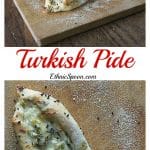

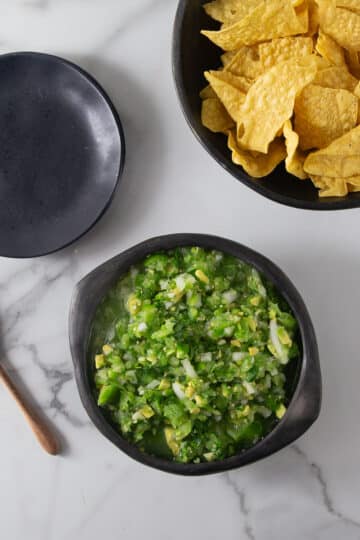
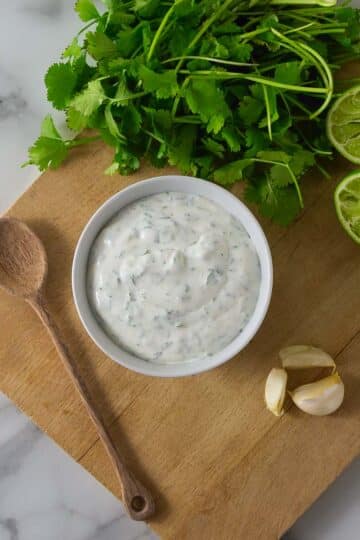
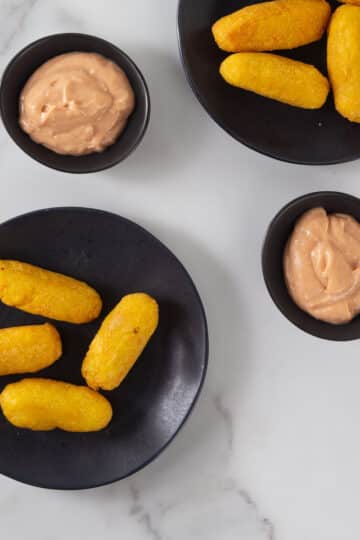
Denise Wright says
This looks delicious Analida! I was just thinking how I wanted to start making my own bread. I love all the flavors too!
Analida says
Thanks Denise. It is very easy to make. You'll see.
Kristen says
Analida, I have never met a carb I don't like either 🙂 Paired with feta, I am all in 🙂
Analida says
YAY Kristen! 🙂
Caroline says
I remember going to a pide restaurant in London a few years back and there were so many great fillings, it was hard to choose. I've kept meaning to try to make it but haven't managed - now I can try your recipe!
Analida says
That's really cool. I am going to make pide again with lamb filling. let me know how it turns out.
Christie says
I have been eyeing this bread to make!! It looks so delicious. I'm with ya on Turkish food. So many flavors in their food it's hard not to love it.
Analida says
Hi Christie! This is so easy to make and so delicious.
I am glad you also like Turkish food.
Patty Oblack says
Love your newly discovered food blog & looking forward to making this bread!
Analida says
Thanks Patty!
Bev says
Came across your recipe on my Pinterest daily feed and had to make it for lunch immediately. Dough was ready in not time as it is hot here in Australia 🇦🇺 cooked in pizza maker in ten minutes. I did add a little chopped baby spinach and spring onion to the parsley...amazing😋 thanks for a great recipe
Analida says
Thanks Bev! I am so glad you liked it!
Dianehaab says
Hi I also love turkish read and i see it is a familiar bread recipie thanks for sharing
Rachel T says
Hi, I made this recipe last night and there were a couple of instructions that I struggled with. The ingredients list says that the egg wash is 1 egg, 1 Tblsp water, but then instruction step #2 says to mix the egg with olive oil, so I wasn't sure if the egg wash was meant to contain water, oil or both.
Then, instruction step 8 says: "Roll dough into a cylinder and divide into 4 equal parts", so I cut the dough into 4 smaller cylinders. But I couldn't make sense of this because each ball of dough wasn't large enough to make a 12" x 3" oval shape, so I ended up combining it all back together and making 1 single pide, rather than 4 smaller ones. Was that right?
I'd love clarification on these problems because this recipe was absolutely delicious and I'd love to make it again. I didn't have feta, so my mix was grated haloumi, cherry tomatoes and spinach.
thanks so much,
Rachel
Analida says
Hi Rachel, Thanks for your questions. I just updated the Turkish Pide recipe this morning with all new step-by-step photos and some clarifications on steps.
To answer your questions:
A little olive oil is used to oil the bowl to prove the dough in and the rest is put in the egg wash.
The dough is rolled into a ball and cut into 4 pieces. Take a look at the update and let me know if you have any questions.
I am so glad you enjoyed the recipe!
Sidra Yaqub says
Can you please tell me roughly how long will it take for the dough to get double in size?
Analida says
Hi Sidra, The rise time is largely depends on the room temperature where you prove the dough. Typical times are 45 minutes for a 70° F room. Proofing drawers are usually 80-90° with 75% humidity and can cut the time in half.
Yvonne Franks says
Love Turkish food. Since living next to a family from Turkey cant get enough of it
Analida says
Thanks Yvonne. Turkish food has some really incredible flavors!
Steph says
I made these yesterday added some spinach and leek to the filling and used poppy seeds because I didn’t have nigella seeds and they are just delicious.
So easy, I will definitely be making them again!
Thank you for sharing the recipe Analida 💕
Analida says
Thanks so much Steph! I am glad you enjoyed this recipe!